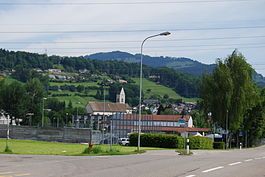Eschenbach, St. Gallen
| Eschenbach | ||
|---|---|---|
 |
||
|
||
| Coordinates: 47°14′N 8°55′E / 47.233°N 8.917°ECoordinates: 47°14′N 8°55′E / 47.233°N 8.917°E | ||
| Country | Switzerland | |
| Canton | St. Gallen | |
| District | See-Gaster | |
| Government | ||
| • Mayor | Josef Blöchlinger | |
| Area | ||
| • Total | 54.86 km2 (21.18 sq mi) | |
| Elevation | 485 m (1,591 ft) | |
| Population (Dec 2015) | ||
| • Total | 9,123 | |
| • Density | 170/km2 (430/sq mi) | |
| Postal code | 8733 / 8735 / 8638 | |
| SFOS number | 3342 | |
| Surrounded by | Jona, Rüti (ZH), Schmerikon, Uznach, Wald (ZH) | |
| Website |
www SFSO statistics |
|
Eschenbach is a municipality in the Wahlkreis (constituency) of See-Gaster in the canton of St. Gallen in Switzerland. On 1 January 2013 the former municipalities of Goldingen and St. Gallenkappel merged into the municipality of Eschenbach.
Eschenbach is first mentioned in 775 as Esghibach. In 829 it was mentioned as Esgithorf.
The name Goldingen was applied to two different hamlets in the municipality. The current hamlet of Goldingen is first mentioned in 1800 and before that time was known as Thal. The hamlet of Vordersagen was first mentioned in 1266 as Goldelingin and until about 1700 was known as Goldingen. Additionally the hamlet of Hintersagen was known until about 1800 as Hintergoldingen.
St. Gallenkappel is first mentioned in 1275 as S. Galli capella. In 1425 it was mentioned as bi Sant Gallencappel, and in the local Swiss German is still known as Chappele. It is located along two old trade and pilgrimage routes, one from Toggenburg over the Laad and the second from Hummelwald to Lake Zurich. In the 9th Century there may have been a chapel dedicated to St. Gallus, where the current parish church now stands. This chapel was the origin of the village name.
On 10 December 1830, St. Gallenkappel was the site of a popular assembly, protesting the loss of freedoms under the Act of Mediation and the Restoration. The assembly at St. Gallenkappel was one of several in the Canton of St. Gallen and throughout Switzerland. They called for two main changes in the cantonal constitution. First, they called for peacefully adjusting the constitutions by adjusting the way seats in local legislatures and the Tagsatzung were allocated. In particular they objected to what they saw as the over-representation of the cantonal capital in the government. Secondly, they sought a way to amend the constitution. Very few cantons even had a way to amend or modify the constitutions, and none of them allowed citizen's initiatives to be added.
...
Wikipedia




